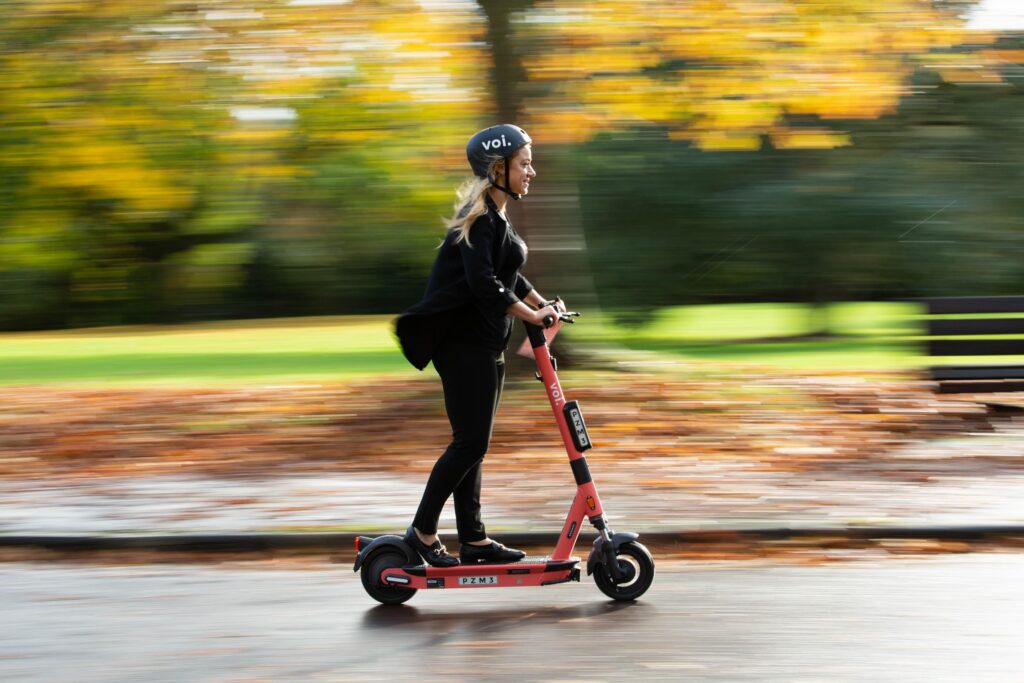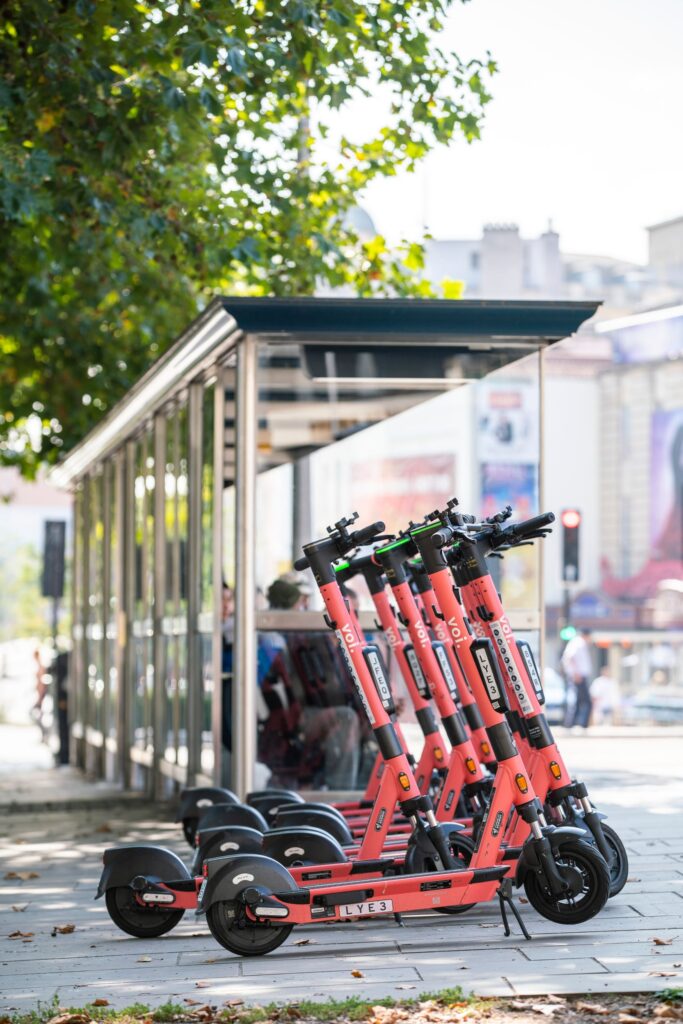Deep Dive with George Lunt
Our Deep Dive series features our technical experts who give you an inside look at how we are solving complex infrastructure challenges for our clients from across the world.
This week, we hear from George Lunt, technical director and new mobility specialist from our Future Mobility team based in Bristol, United Kingdom, as he discusses his work leading an innovative e-scooter trial in the south-west of England.
The West of England region is one of just four Future Transport Zones (FTZ) in the country, set up to trial the latest innovations for creating convenient, accessible alternatives to car travel and encourage a much-needed modal shift.
Hailed as the most successful trial of its kind in England, this e-scooter project — run by the West of England Combined Authority and part of the FTZ — demonstrates the exciting potential of this green and cost-effective mode of transport being rolled out on a wider scale elsewhere.
With 20 years of industry experience, George has a wealth of knowledge and technical expertise, having previously led the Capri autonomous vehicle (AV) trials in Bristol and at London’s Olympic Park — a three-year project that made great strides in building public trust and accelerating momentum for AVs in the UK.
Tell us more about the micro-mobility trial you are leading in the West of England and how it is benefiting communities and the environment.
Currently, I am working with the West of England Combined Authority — the overarching transport authority that covers Bath and North East Somerset, Bristol and South Gloucestershire — to support the FTZ.
As part of this programme, several projects are underway that AECOM is closely involved in, including Mobility Hubs, which is trialling more community-focused transport interchanges; Mobility as a Service, which streamlines integrated journey planning and ticketing onto one smartphone app; and Demand Responsive Transport (DRT), which is replacing traditional fixed bus routes by enabling drivers to be more agile and dynamic about where people are picked up enroute.
Although I am involved in all these projects in some shape or form, the project I have been working most closely with is the e-scooter trial, which I am currently leading. Launched almost three years ago, this trial is the most successful of its kind in England — if not in Europe — and has been highly popular in the West of England, providing real benefits to local communities. Since the trial started, there have been 430,000 users and more than 12 million rides.
As part of this work, we have been collaborating with the University of the West of England to evaluate the impact of scooter users and so far, from the surveys we’ve done of participants in these trials, we’re seeing a shift away from all other forms of transport. When you take all the changes into account, we are seeing that the e-scooter trial has contributed to reduced carbon emissions across the whole region. So, in terms of having an impact on carbon and air quality, that’s an immediate benefit that we can demonstrate.
This trial is the most successful of its kind in England — if not in Europe — and has been highly popular in the West of England, providing real benefits to local communities.”
In addition, we’re looking at individual stories from users through in-depth interviews. The remarkable thing is that when you start talking to users, you see how much they’re embedding this mode of transport into their daily lives. People are telling us stories about how accessible the scooters are and how they’re enabling them to undertake trips they would not have been able to do before.
One of the nice things about the trial in the West of England is that there are significant discounts for people who are on income support, such as Jobseeker’s Allowance. This way, we can really target interventions to the right people in the right way — and that’s because the e-scooters are technology-enabled and app-based. Thanks to the ease in which these kinds of initiatives can be implemented, using digital technology, positive impacts can be made at pace.
The next phase of the trial is to try and take some of the things we’re doing with e-scooters and move them over to rental e-bikes. We’re especially keen on this because e-bikes enable you to travel longer distances more comfortably, so the overall carbon impact is going to be greater.
Ultimately, what we want to do is to integrate with other modes of transport that enable people to travel more sustainably — such as making it easier for people to get to a train or bus stop, when they might have otherwise taken a taxi or driven. By trialling this project here in a part of the West of England, we can create a blueprint, if you like, for being able to roll it out more significantly across the wider region.
The remarkable thing is that when you start talking to users, you see how much they’re embedding this mode of transport into their daily lives. People are telling us stories about how accessible the scooters are and how they’re enabling them to undertake trips they would not have been able to do before.”
Did you come across any challenges during the project and how did you overcome them?
We certainly came across challenges on the e-scooter trial. I prefer to think of them as opportunities though, because the whole point of these projects is to learn from them. So, I think if you don’t have challenges, it means you’re not pushing the boundaries far enough and you’re not challenging yourself to get the most learning.
Some of the difficulties have been around striking the right balance between having enough e-scooters on the road to make it a convenient service for users, whilst keeping them tidy and organised so that it prevents street clutter. When it comes to valuable road users — like blind or partially-sighted people, or people with wheelchairs — poorly parked e-scooters on already cluttered footways are a big challenge.
What we’re looking to do over time is to introduce more on-road parking where possible, because in my view, the footways need to be for pedestrians. But we also didn’t want that to be a barrier to the whole trial from the outset. So, that’s been a challenge in terms of the logistical side of things: How do you educate people to park in the right way and be compliant, and how do you push the operator to enforce those rules and get the message out there?
This requires a strong relationship between the Transport Authority and the local Highway Authority responsible for maintaining public highways. The goal is getting that partnership right, identifying where the correct parking areas should be, and getting them signed off and approved across all parties to get that working.
Another challenge was helping to reverse negative perceptions of e-scooters, such as people reporting e-scooter riders jumping red lights and riding on the footway, etc. We really need to listen to those concerns and use the technology and all the measures we have to improve that. Interesting our research shows that e-scooter riders and cyclists have similar levels of compliance, whether it be jumping red lights, riding on the footway, and other inappropriate behaviour. So, this demonstrates to me the need for better infrastructure. For example, our research shows that people often feel the need to ride on a footway because they feel it’s too dangerous to ride on the road. Therefore, the big uptake of e-scooter riding in the West of England really helps put forward the case for better cycling and e-scooter infrastructure in general.
When it comes to valuable road users — like blind or partially-sighted people, or people with wheelchairs — poorly parked e-scooters on already cluttered footways are a big challenge.”
What lessons have you learned from this project and how are you going to take them forward into your future work?
A big lesson I’ve learned is the level of collaboration that’s needed to make things work at scale. In terms of the e-scooter trial’s success, that’s largely down to the collaborative work that we’ve done with the West of England Combined Authority, the operator and the Unitary Authorities — as well as all the wider stakeholders including the police and fire service.
We’ve also worked with an equality group — which supports valuable road users — and universities. The University of Bristol, for instance, has done some quite innovative retrofitting of air quality sensors on scooters and is currently trialling that technology. I have learnt a massive amount by working with all the great people on my team too. Another key factor for success is investment. We’ve been fortunate in the West of England that the trial has been partly funded by the FTZ. This has enabled us to give the project the attention it needs and deserves to make it a success.
In terms of the e-scooter trial’s success, that’s largely down to the collaborative work that we’ve done with the West of England Combined Authority, the operator and the Unitary Authorities — as well as all the wider stakeholders including the police and fire service.”








